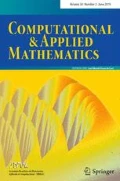Abstract
Terrestrial solar power is severely limited by the diurnal day–night cycle. To overcome these limitations, a Solar Power Satellite (SPS) system, consisting of a space mirror and a microwave energy generator-transmitter in formation, is presented. The microwave transmitting satellite (MTS) is placed on a planar orbit about a geostationary point (GEO point) in the Earth’s equatorial plane, and the space mirror uses the solar pressure to achieve orbits about GEO point, separated from the planar orbit, and reflecting the sunlight to the MTS, which will transmit energy to an Earth-receiving antenna. Previous studies have shown the existence of a family of displaced periodic orbits above or below the Earth’s equatorial plane. In these studies, the sun-line direction is assumed to be in the Earth’s equatorial plane (equinoxes), and at \(23.5^{\circ }\) below or above the Earth’s equatorial plane (solstices), i.e. depending on the season, the sun-line moves in the Earth’s equatorial plane and above or below the Earth’s equatorial plane. In this work, the position of the Sun is approximated by a rectangular equatorial coordinates, assuming a mean inclination of Earth’s equator with respect to the ecliptic equal to \(23.5^{\circ }\). It is shown that a linear approximation of the motion about the GEO point yields bounded orbits for the SPS system in the Earth–satellite two-body problem, taking into account the effects of solar radiation pressure. The space mirror orientation satisfies the law of reflection to redirect the sunlight to the MTS. Additionally, a MTS on a common geostationary orbit (GEO) has been also considered to reduce the relative distance in the formation flying Solar Power Satellite (FF-SPS).








Similar content being viewed by others
References
Baig S, McInnes CR (2010) Light-levitated geostationary cylindrical orbits are feasible. J Guid Control Dyn 33(3):782–793. doi:10.2514/1.46681
Billman KW, Gilbreath WP, Bowen SW (1977a) Introductory assessment of orbiting reflectors for terrestrial power generation, NASA TM X-23, p 230
Billman KW, Gilbreath WP, Bowen SW (1977b) Satellite mirror systems for providing terrestrial power: system concept. In: Paper AAS-77-240, 23rd meeting of the AAS. San Francisco, CA, Oct 1977
Carrington C, Feingold H (2000) SSP systems integration, analysis and modelling. In: SSP technical interchange meeting #3, Huntsville, AL, 19–23 June 2000
Ehricke KA (1979) Space light: space industrial enhancement of the solar option. Acta Astronaut 6(12):1515–1633
Fischer H, Haerting A (1992) Why light-levitation geostationary cylindrical orbits are not feasible. J Astronaut Sci 40(3):329–333
Forward RL (1981) Light-levitated geostationary cylindrical orbits. J Astronaut Sci 29(1):73–80
Forward RL (1984) Light-levitated geostationary cylindrical orbits using perforated light sails. J Astronaut Sci 32(2):221–226
Forward R (1991) Statite: a spacecraft that does not orbit. J Spacecr Rocket 28(5):606–611. doi:10.2514/3.26287
Glaser PE (1968) Power from the sun: its future. Science 162:857–861
Intergovernmental Panel on Climate Change (IPCC) (2001) Climate change 2001: synthesis report. IPCC, Washington, DC
International Energy Agency (IEA) (2016) Key world statistics. IEA, Paris, pp 6–7. doi:10.1787/key_energ_stat-2016-en
Krivov AV, Sokolov LL, Dikarev VV (1995) Dynamics of Mars-orbiting dust: effects of light pressure and planetary oblateness. Celest Mech Dyn Astron 63(3):313–339. doi:10.1007/BF00692293
McInnes CR (1999) Solar sailing: technology, dynamics and mission applications. Springer Praxis, London
McInnes C, McDonald A, Simmons J, McDonald E (1994) Solar sail parking in restricted three-body systems. J Guid Control Dyn 17(2):399–406
Mori M, Nagayama H, Saito Y, Matsumoto H (2001) Summary of studies on space solar power systems of national space development agency of Japan. In: IAF-01-R.1.04. 52nd international astronautical congress, Toulouse, France, Oct 2001
Oda M, Mori M (2003) Stepwise development of SSPS, JAXA’s current study status of the 1GW class operational SSPS and its precursor. In: IAC-03-R.3.03. 54th international astronautical congress, Bremen, German, Sept–Oct 2003
Renewable Energy Policy Network for the 21st Century (REN21) (2016) Renewables 2016 global status report. REN21, Paris, pp 62–63
Salazar FJT, McInnes CR, Winter OC (2017) Periodic orbits for space-based reflectors in the circular restricted three-body problem. Celest Mech Dyn Astron 128(1):95–113. doi:10.1007/s10569-016-9739-3
Takeichi N, Ueno H, Oda M (2005) Feasibility study of a solar power satellite system configured by formation flying. Acta Astronaut 57:698–706. doi:10.1016/j.actaastro.2005.02.006
Turner AE (2006) Power transfer for formation flying spacecraft. In: AIAA 2006-7493. Space 2006 conference, San Jose, 19–21 Sept 2006
van de Kolk C (1999) Stability of levitated cylindrical orbits by using solar sails. In: AAS/AIAA astrodynamics specialist conference, Gridwood, AK. American Astronautical Society Paper, Aug 1999, pp 99–335
Wie B, Roithmayr CM (2001) Integrated orbit, attitude, and structural control systems design for space solar power satellites. NASA TM-2001-210854, June 2001
Acknowledgements
First, authors thank the financial support of the FAPESP (São Paulo Research Foundation, Brazil), Grants 2011/08171-3, 2013/03233-6 and the CNPq (National Council for Scientific and Technological Development, Brazil), and the technical support of University of Glasgow. C.R.M. was support by an Engineering and Physics Research Council (EPSRC) Institutional Sponsorship Grant and a Royal Society Wolfson Research Merit Award.
Author information
Authors and Affiliations
Corresponding author
Additional information
Communicated by Elbert Macau, Antônio Fernando Bertachini de Almeida Prado and Othon Cabo Winter.
Rights and permissions
About this article
Cite this article
Salazar, F.J.T., Winter, O.C. & McInnes, C.R. Collecting solar power by formation flying systems around a geostationary point. Comp. Appl. Math. 37 (Suppl 1), 84–95 (2018). https://doi.org/10.1007/s40314-017-0473-6
Received:
Revised:
Accepted:
Published:
Issue Date:
DOI: https://doi.org/10.1007/s40314-017-0473-6
Keywords
- Solar Power Satellite system
- Formation flying
- Microwave transmitting satellite
- Geostationary point
- Two-body problem
- Solar radiation pressure




